Uncategorized
Crypto Daybook Americas: USDC Takes January Crown as Bitcoin Looks to Core PCE Data
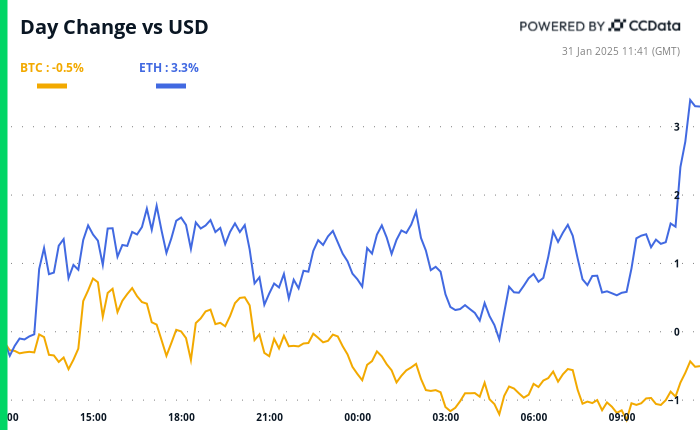
By Omkar Godbole (All times ET unless indicated otherwise)
The crypto market is treading water and the biggest cryptocurrency, bitcoin, is taking a bull breather. Its upward momentum is getting stifled by Trump’s renewed tariff threats, which are also sending gold prices soaring to record highs and propping up demand for the U.S. dollar.
But there is action in some corners of the market. The VIRTUAL token popped after its recent listing on Upbit, and Hyperliquid’s HYPE token has seen a 3% gain. Litecoin is also making waves, with its perpetual futures open interest on centralized exchanges climbing to 5.19 million LTC, the most since Dec. 9, according to Coinglass. The surge hints at fresh capital flowing into the market, likely fueled by hopes of a spot ETF listing in the U.S.
Speaking of stablecoins, USDC is stealing the spotlight as the star performer this month, boasting a remarkable market cap growth of 21% to $53.12 billion. That’s its best month since May 2021, according to TradingView data. In contrast, USDT, the heavyweight champion of dollar-pegged stablecoins, eked out just a 1% increase. USDC even outperformed bitcoin, which grew a respectable 10%.
According to IntoTheBlock, USDC’s outperformance is likely due to its compliance with Europe’s MiCA regulations, while rivals like USDT face tough headwinds. But don’t count USDT out just yet; its market is starting to bounce back, and the simultaneous growth of USDC is offering a bullish impulse for the crypto market.
As we keep an eye on the macro landscape, the pivotal U.S. core PCE — the Fed’s go-to measure for inflation — is set to be released. Expectations are for a hot headline figure, with core reading, which excludes food and energy, showing positive improvements that might help BTC break out of its dull price action near $104,000.
However, ING is cautioning that the dollar might stay strong into the weekend.
“If we don’t receive any news on Canada and Mexico by the end of today, there’s a risk that the dollar could strengthen further as the market starts to price in a higher chance of tariffs being announced tomorrow,” it wrote. So, stay alert!
What to Watch
Crypto:
Jan. 31: Crypto.com is suspending purchases of cryptocurrencies USDT, WBTC, DAI, PAX, PAXG, PYUSD, CDCETH, CDCSOL, LCRO, and XSGD in the EU to comply with MiCA regulations. Withdrawals will be supported through Q1.
Feb. 2, 8:00 p.m.: Core blockchain Athena hard fork network upgrade (v1.0.14)
Feb. 4: Pepecoin (PEPE) halving. At block 400,000, the reward will drop to 31,250 PEPE.
Feb. 5, 3:00 p.m.: Boba Network’s Holocene hard fork network upgrade for its Ethereum-based layer-2 mainnet.
Feb. 5 (after market close): MicroStrategy (MSTR) Q4 FY 2024 earnings.
Feb. 6, 8:00 a.m.: Shentu Chain network upgrade (v2.14.0).
Feb. 11 (after market close): Exodus Movement (EXOD) Q4 2024 earnings.
Feb. 12 (before market open): Hut 8 (HUT) Q4 2024 earnings.
Feb. 13: CleanSpark (CLSK) Q1 FY 2025 earnings.
Feb. 13 (after market close): Coinbase Global (COIN) Q4 2024 earnings.
Feb. 15: Qtum (QTUM) hard fork network upgrade at block 4,590,000.
Feb. 18 (after market close): Semler Scientific (SMLR) Q4 2024 earnings.
Feb. 20 (after market close): Block (XYZ) Q4 2024 earnings.
Feb. 26: MARA Holdings (MARA) Q4 2024 earnings.
Feb. 27: Riot Platforms (RIOT) Q4 2024 earnings.
March 4: Cipher Mining (CIFR) releases Q4 2024 earnings.
Macro
Jan. 31, 8:30 a.m.: The U.S. Bureau of Economic Analysis (BEA) releases December’s Personal Income and Outlays report.
Core PCE Price Index MoM Est. 0.2% vs. Prev. 0.1%.
Core PCE Price Index YoY Est. 2.8% vs. Prev. 2.8%.
PCE Price Index MoM Est. 0.3% vs. Prev. 0.1%.
PCE Price Index YoY Est. 2.6% vs. Prev. 2.4%.
Feb. 2, 8:45 p.m.: China’s Caixin releases January’s Manufacturing PMI report.
Manufacturing PMI Est. 50.5 vs. Prev. 50.5.
Token Events
Governance votes & calls
Compound DAO is voting on an upgrade of its governance contracts from GovernorBravo to OpenZeppelin’s modern Governor implementation.
Balancer DAO is voting whether to initiate a token swap between Balancer DAO and CoW DAO involving 200,000 BAL tokens and around 631,000 COW tokens.
Unlocks
Jan. 31: Optimism (OP) to unlock 2.32% of circulating supply worth $46.39 million.
Feb. 1: Sui (SUI) to unlock about 2.13% of its circulating supply worth $261.91 million.
Feb. 2: Ethena (ENA) to unlock about 1.34% of its circulating supply worth $29.53 million.
Token Listings
Jan. 31: Movement (MOVE), Virtuals Protocol (VIRTUAL) and Sundog (SUNDOG) to be listed on Indodax.
Conferences:
Day 3 of 3: Crypto Peaks 2025 (Palisades, California)
Day 2 of 2: Ethereum Zurich 2025
Day 2 of 2: Plan B Forum (San Salvador, El Salvador)
Day 2 of 3: Crypto Gathering 2025 (Miami Beach, Florida)
Day 2 of 3: CryptoXR 2025 (Auxerre, France)
Day 2 of 4: Oasis Onchain 2025 (Nassau, Bahamas)
Day 2 of 6: The Satoshi Roundtable (Dubai)
Feb. 3: Digital Assets Forum (London)
Feb. 5-6: The 14th Global Blockchain Congress (Dubai)
Feb. 6: Ondo Summit 2025 (New York).
Feb. 7: Solana APEX (Mexico City)
Feb. 13-14: The 4th Edition of NFT Paris.
Feb. 18-20: CoinDesk’s Consensus Hong Kong
Feb. 19: Sui Connect: Hong Kong
Feb. 23-March 2: ETHDenver 2025 (Denver, Colorado)
Feb. 25: HederaCon 2025 (Denver)
Derivatives Positioning
TRX, TRUMP and OM registered the biggest increase in perpetual futures open interest. Traders, however, seem to be shorting TRUMP, as evident from the negative cumulative volume delta.
BTC, ETH open interest and CVD are little changed. The BTC CME basis is hovering around 10%.
Flows in Deribit’s options market have been muted, but BTC and ETH calls continue to trade pricier than puts.
Market Movements:
BTC is down 0.29% from 4 p.m. ET Thursday to $104,810.50 (24hrs: -0.47%)
ETH is up 2.39% to $3,324 (24hrs: +3.32%)
CoinDesk 20 is down 0.3% to 3,838.81 (24hrs: +0.28%)
CESR Composite Staking Rate is up 4 bps to 3.07%
BTC funding rate is at 0.0012% (1.2961% annualized) on OKX
DXY is up 0.47% at 108.30
Gold is unchanged at $2,794.77/oz
Silver is up 0.19% at $31.60/oz
Nikkei 225 closed +0.15% to 39,572.49
Hang Seng closed +0.14% to 20,225.11
FTSE is up 0.3% at 8,673.13
Euro Stoxx 50 is up 0.39% at 5,302.75
DJIA closed on Thursday +0.38% to 44,882.13
S&P 500 closed +0.53% to 6,071.17
Nasdaq closed +0.25% to 19,681.75
S&P/TSX Composite Index closed +1.31% to 25,808.25
S&P 40 Latin America closed +2.21% to 2,388.03
U.S. 10-year Treasury is up 2 bps at 4.536%
E-mini S&P 500 futures are up 0.43% at 6,125.75
E-mini Nasdaq-100 futures are up 0.79% at 21,795.50
E-mini Dow Jones Industrial Average Index futures are up 0.32% at 45,200.00
Bitcoin Stats:
BTC Dominance: 59.21 (-0.11%)
Ethereum to bitcoin ratio: 0.03127 (0.84%)
Hashrate (seven-day moving average): 781 EH/s
Hashprice (spot): $61.7
Total Fees: 4.97 BTC/ $522,698
CME Futures Open Interest: 176,270 BTC
BTC priced in gold: 37.3 oz
BTC vs gold market cap: 10.60%
Technical Analysis
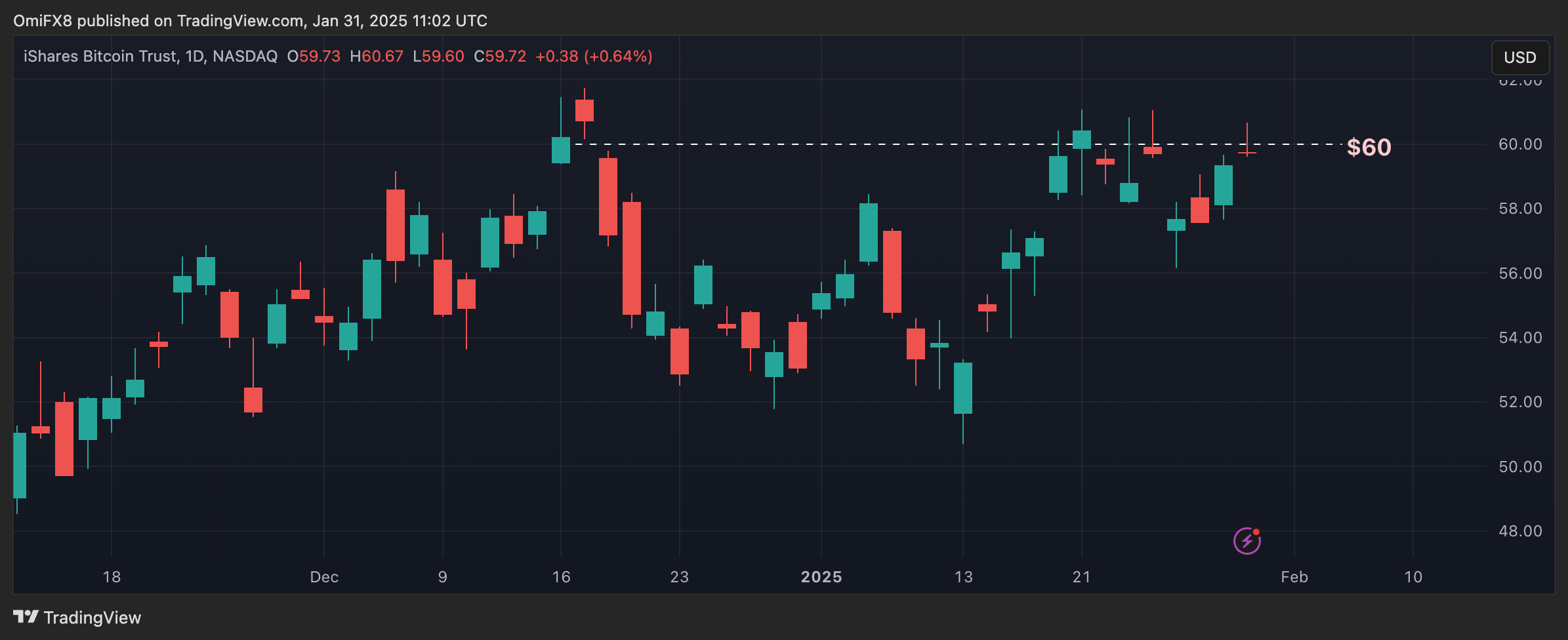
The chart shows $60 has emerged as a strong resistance for BlackRock’s IBIT exchange-trade fund since December, with bulls consistently failing to establish a foothold above that level.
Such patterns represent bullish exhaustion and often pave the way for minor price pullbacks that shake out weak hands, setting the stage for the next leg higher.
Crypto Equities
MicroStrategy (MSTR): closed on Thursday at $340.09 (-0.34%), up 0.2% at $340.77 in pre-market.
Coinbase Global (COIN): closed at $301.30 (+3.54%), down 0.17% at $300.80 in pre-market.
Galaxy Digital Holdings (GLXY): closed at C$29.33 (+0.83%).
MARA Holdings (MARA): closed at $19.18 (+4.13%), up 0.36% at $19.25 in pre-market.
Riot Platforms (RIOT): closed at $11.90 (+6.06%), up 0.76% at $11.99 in pre-market.
Core Scientific (CORZ): closed at $12.26 (+6.98%), up 3.18% at $12.65 in pre-market.
CleanSpark (CLSK): closed at $10.97 (+6.92%), up 0.55% at $11.03 in pre-market.
CoinShares Valkyrie Bitcoin Miners ETF (WGMI): closed at $22.50 (+6.33%), up 3.47% at $23.28 in pre-market.
Semler Scientific (SMLR): closed at $52.15 (+0.13%).
Exodus Movement (EXOD): closed at $61.38 (-31.27%), down 2.23%% at $60.01 in pre-market.
ETF Flows
ETF Flows
Spot BTC ETFs:
Daily net flow: $588.2 million
Cumulative net flows: $40.18 billion
Total BTC holdings ~ 1.18 million.
Spot ETH ETFs
Daily net flow: $67.77 million
Cumulative net flows: $2.73 billion
Total ETH holdings ~ 3.65 million.
Source: Farside Investors
Overnight Flows
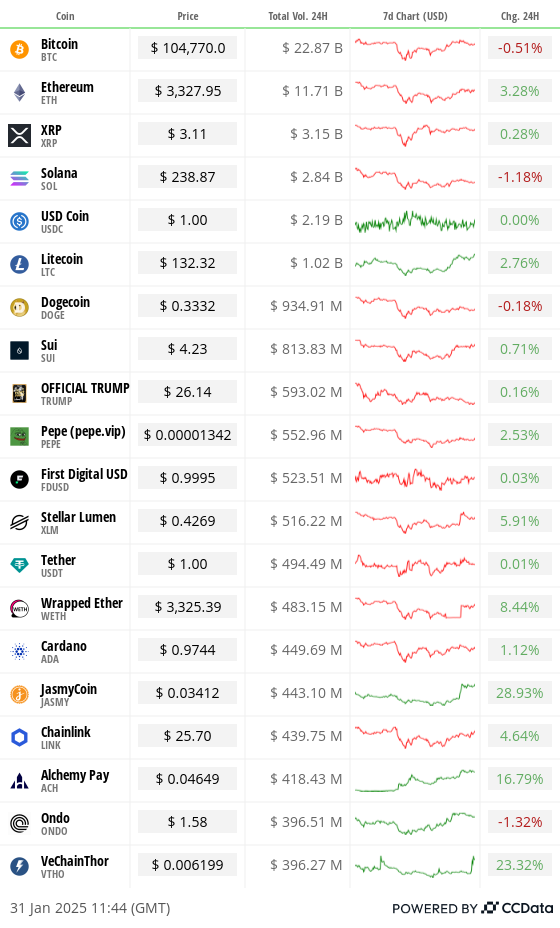
Chart of the Day
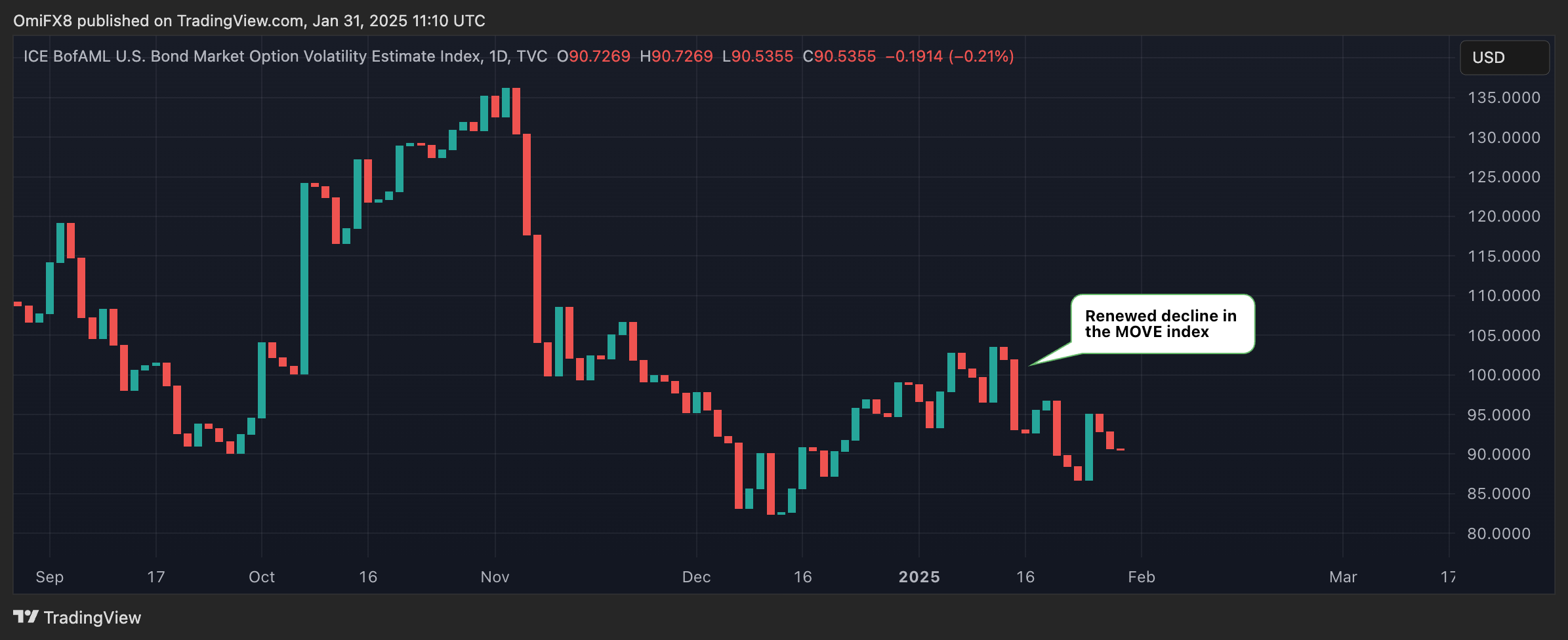
The MOVE index, which represents an options-based measure of how volatile the U.S. Treasury market is likely to become in the next four weeks, has turned lower.
Declining Treasury market volatility often bodes well for risky assets.
While You Were Sleeping
Bitcoin Steady, Gold Tokens Shine as XAU Hits Record High; Inflation in Tokyo Rises (CoinDesk): President Trump’s tariff threats are a headwind for bitcoin, but derivatives data indicate skepticism toward a major downturn, with traders remaining bullish and growing interest in state-level BTC reserves.
Grayscale Files SEC Proposal to Convert XRP Trust Into ETF (CoinDesk): On Thursday, NYSE Arca filed a Form 19b-4 with the SEC to list shares of Grayscale’s XRP Trust as an ETF.
VIRTUAL Surges 28% as Upbit Listing Exposes the Token to Altcoin Savvy South Koreans (CoinDesk): The price of VIRTUAL, the native token of Virtuals Protocol, a decentralized platform on the Base blockchain for creating AI agents, surged after Upbit said it would list the token.
Trump Is Getting the Lower Interest Rates He Demanded From Everyone but the Fed (Reuters): Despite Trump’s calls for rate cuts, the Fed remains hawkish, while the Bank of Canada, Bank of England and European Central Bank are easing monetary policy.
Trump Says 25% Tariffs on Mexico and Canada May Not Include Oil (CNBC): Trump confirmed on Thursday that 25% tariffs on Mexican and Canadian imports will start Feb. 1 but left oil uncertain.
Japan’s Economy Faces Fallout From Trump’s China Tariff Threats (Bloomberg): Japan’s chief economist, Tomoko Hayashi, said a U.S.-China trade war could hurt her country’s economy, though she believes firms are better prepared now than during Trump’s first term.
In the Ether
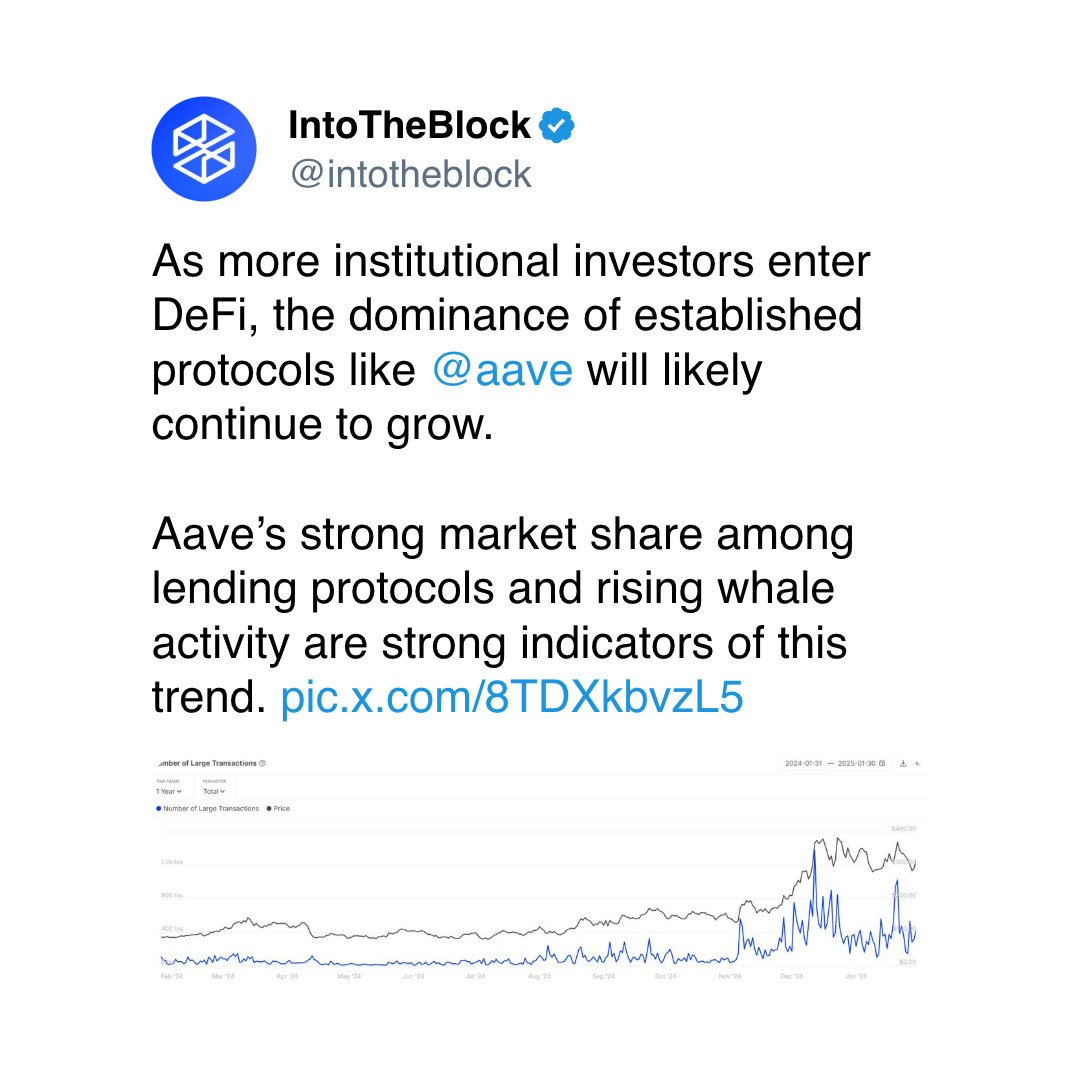
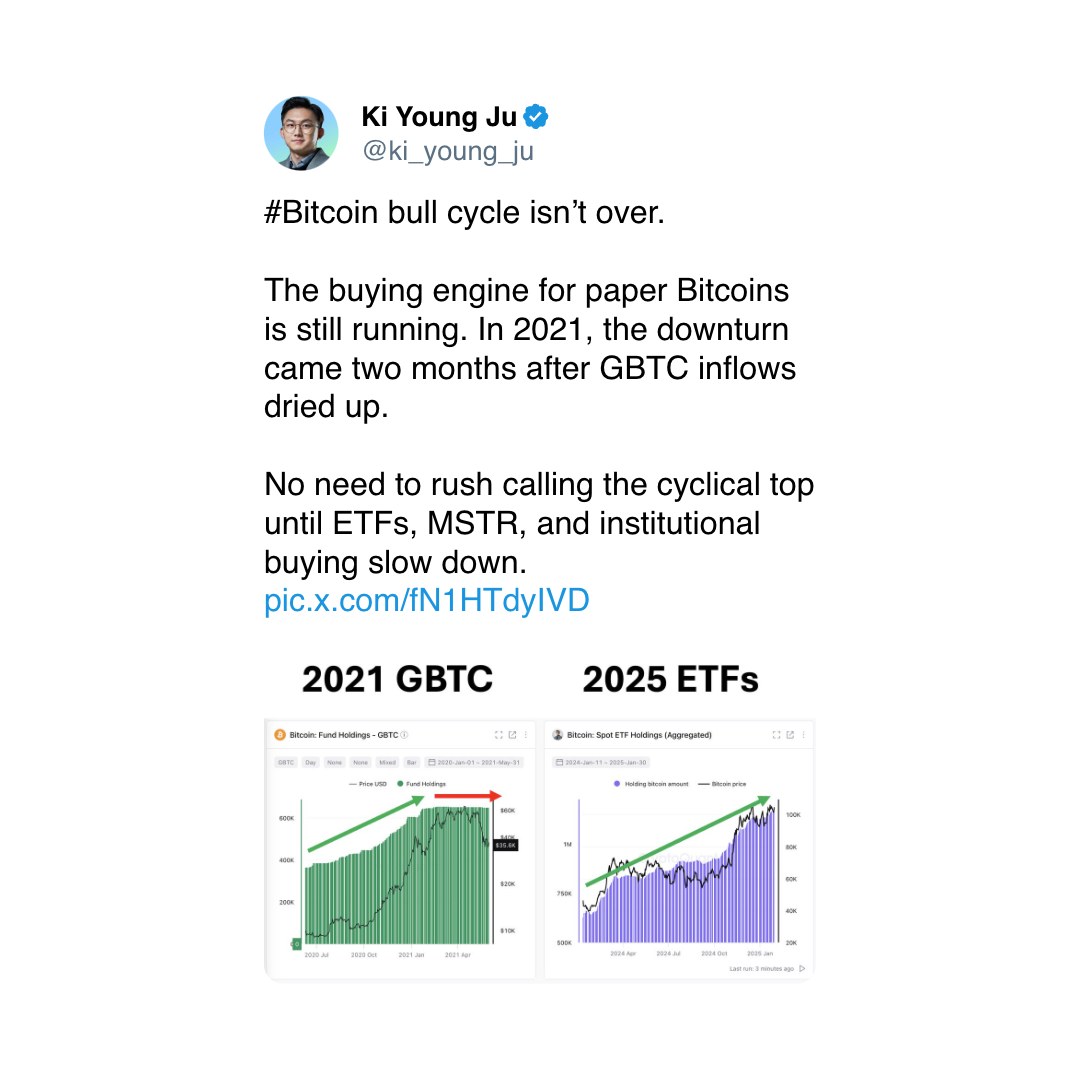



Uncategorized
Elon Musk vs. the regulators
Welcome back to TechCrunch Mobility, your hub for all things “future of transportation.”
Uncategorized
Nvidia’s AI empire: A look at its top startup investments
Over the last two years, Nvidia has used its ballooning fortunes to invest in over 100 AI startups. Here are the giant semiconductor’s largest investments.
Uncategorized
Dating app Cerca will show how Gen Z really dates at TechCrunch Disrupt 2025
Cerca is a dating app that sets users up with mutual friends.
-

 Business12 месяцев ago
Business12 месяцев ago3 Ways to make your business presentation more relatable
-

 Fashion12 месяцев ago
Fashion12 месяцев agoAccording to Dior Couture, this taboo fashion accessory is back
-

 Entertainment12 месяцев ago
Entertainment12 месяцев ago10 Artists who retired from music and made a comeback
-

 Entertainment12 месяцев ago
Entertainment12 месяцев ago\’Better Call Saul\’ has been renewed for a fourth season
-

 Entertainment12 месяцев ago
Entertainment12 месяцев agoNew Season 8 Walking Dead trailer flashes forward in time
-

 Business12 месяцев ago
Business12 месяцев ago15 Habits that could be hurting your business relationships
-

 Entertainment12 месяцев ago
Entertainment12 месяцев agoMeet Superman\’s grandfather in new trailer for Krypton
-

 Entertainment12 месяцев ago
Entertainment12 месяцев agoDisney\’s live-action Aladdin finally finds its stars


